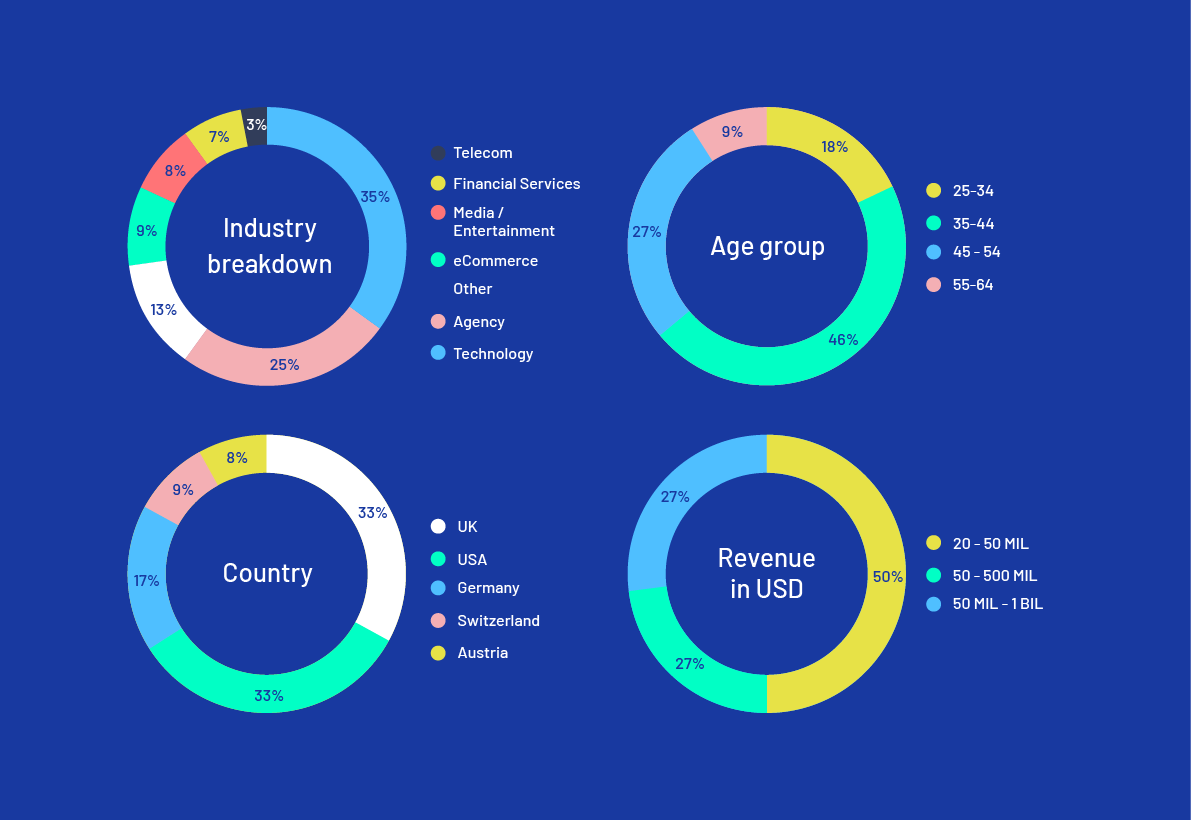Data, People, and Culture:
The Evolving Role of the Modern CMO



In April of 2022, Adverity commissioned a survey of 300 CMOs from small and midsize businesses (SMBs) across the US, UK, and DACH region (Germany, Austria, and Switzerland).
Respondents were interviewed over the telephone, and represent a wide range of industries, including Technology, Marketing Agencies, and eCommerce.
Respondents came from small and midsize businesses as defined by Gartner; small businesses are defined as organizations with an annual revenue of between 20 million and 50 million USD while mid-sized enterprises are defined as organizations with an annual revenue of between 50 million to 1 billion USD.
Making strategic decisions is central to the role of any CMO. Where should we commit our budget? What channels are going to perform the best? What creative is going to get the best ROAS? Who should we target and how will that deliver against the company's bottom line?
As marketing becomes ever more digitalized, the amount of data available to marketing teams presents both a huge opportunity as well as a significant challenge — how do you continue making decisions in an increasingly complex landscape?
As this report shows, while CMOs at SMBs don’t see their ultimate role changing — it will always revolve around determining strategy and delivering growth — how this is accomplished, how they make decisions, is likely to evolve significantly over the next 10 years.
The rise of new technology, AI especially, will play a huge role in this. But so too will the fact that marketing departments, and their CMOs by extension, need to become increasingly more data-driven and insight-oriented. In what is an already crowded digital marketplace, developing a business culture that emphasizes the importance of data, and making decisions based on data, is paramount.
Importantly, as this report suggests, the majority of CMOs surveyed are clearly aware of these needs with many having already taken steps to address technological and cultural challenges within their organization. That 73% of the CMOs at SMBs surveyed have committed to investing in a marketing ops role but only 12% have had this role for more than a year, is indicative of how quickly things are changing. We recommend that all CMOs take a look at this report in order to fully prepare for how their role, and the role of their department, is evolving.
Alexander Igelsböck, CEO, Adverity
The past ten years have seen a tidal wave of new platforms and channels that have further complicated the already complex landscape of marketing. The explosion of activity, in particular around video and audio platforms like Spotify and TikTok, has created huge windows of opportunity for those who are fast to act. In short, adaptation has been the name of the game for CMOs at SMBs. With marketing teams slowly acclimatizing to this rate of change and finding new tools to take on the increasing complexity, we asked our respondents to predict what’s on the horizon for the next decade.
Overall, the CMOs surveyed expect to retain similar goals over the next 10 years, however, the general consensus is that the way they reach these goals will shift. Growth, for example, will still be a major driver, but the method the marketing team achieves growth will look very different as companies adapt to new technologies, and in particular, AI.
CMOs expect that these will aid in much better visibility and speedier decision-making, and will open up time to focus on execution rather than analysis and strategy. In other words, they want to spend less time getting data insights and more time using them to make decisions.
Currently, 43% of CMOs surveyed say their team spends more time getting data in one place than they do actually using it to make decisions. Being able to make timely data-driven decisions is a huge competitive advantage, but there’s still a long way to go before teams are data mature enough to do this consistently, and even further before they can make use of AI and predictive analytics.
So, it’s no surprise that streamlining the process of getting timely insights from data is going to be a key focus in the coming years. And while the CMOs we surveyed recognize that tech has a key role to play here, the people and culture within an organization are also critical contributors to building out a data-driven strategy.
Almost half of marketing teams at SMBs now have someone in a marketing operations role. With a third of CMOs having introduced this role within the last year and a further 28% currently hiring, this indicates an accelerating need for a full-time dedicated person to manage the department’s martech stack.
However, it is telling that more than half (55%) still lack someone responsible for operations, with only 1 in 10 companies having had someone in a marketing operations role for more than a year.
A marketing ops role is dedicated full-time to managing your martech stack, improving data quality, and analyzing available data to improve efficiency and outcomes.
With so much data streaming in from different sources, marketers will often find themselves working in silos, so an outside perspective can be really helpful. It’s the job of the marketing ops role to smash those silos inside and outside your team and to analyze the big picture. By connecting data and processes, they make the marketing team more successful, and the company more competitive.
The evidence is mounting that a data-driven strategy is key to long-term success. A majority of respondents say that their teams review their marketing data in order to make decisions on a weekly or monthly basis. However, only 1 in 10 CMOs surveyed say their teams are constantly monitoring and using timely data to make decisions. On top of that, 30% of CMOs say their teams only review marketing data once a quarter or less.
The marketing landscape moves quickly and as digitalization increases, so too will the need for marketing teams to improve their overall data and analytical maturity. A crucial pillar of this is developing a data-driven culture that places data at the heart of decision-making. CMOs at SMBs are advised to encourage, at least, weekly monitoring of marketing performance data so that campaigns can be adjusted and optimized on the fly and any issues, trends, or anomalies are identified early in order to maximize ROI and drive performance.
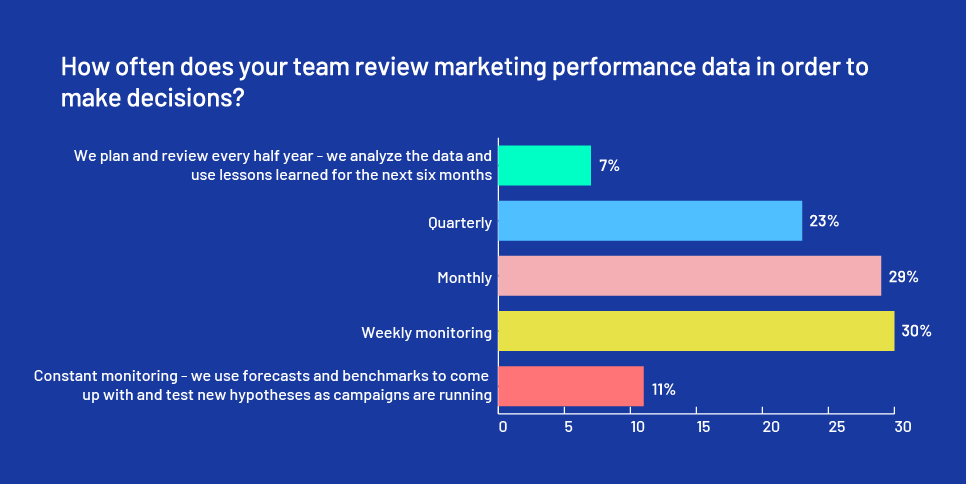
“Metrics should be used on a day-by-day basis. We spend 10, 15 minutes just walking through the metrics every single morning. And if we can see something is starting to move off trend or if there's an opportunity emerging, we quickly dig into the underlying data and the underlying trend.”
“A personal mantra of mine is, how do you deliver insights at the speed of business?” says Jeff Coleman, Leader of Digital Marketing Science, Carter's.
When Jeff joined the Carter's team in March 2021 it soon became apparent that there were a lot of manual processes going on. “Our channel managers were inundated with pulling data in a manual way from disparate platforms. One of my goals was to see how quickly we could move out of that manual space of collecting data in spreadsheets.”
“I wanted to transition the mindset from ‘where's this report’ to ‘what is the analytics guiding us to do as a business’. I wanted to make sure we’d have the insights at our fingertips when it’s time to make a business decision. I spent a lot of my first year getting the table stakes out of the way and getting the tools and data lakes set up for the future success we want.”
When we asked respondents what was delaying or limiting decision making, those in smaller companies (between 20 million USD and 50 million USD in annual revenue) exhibited significant differences from those in larger companies (between 500 million USD and 1 billion USD in annual revenue).
The most pressing issue for the smaller companies surveyed, and the third most challenging overall, was difficulty comparing performance across channels and platforms (19%). This is the main cause of delays for just 13% of respondents from larger companies, but for smaller companies, this number jumps to 25% to take the top spot.
Smaller companies are advised to lay the foundations for visibility over marketing channels and platforms now, so that as their company grows their data strategy naturally follows.
Across all company sizes, 21% of CMOs surveyed say the biggest challenge that delays or limits decision-making is changing campaign KPIs, and 20% say their biggest struggle is last-minute creative changes. This is especially true of larger organizations, which can often face more red tape and bottlenecks to get last-minute changes in motion.
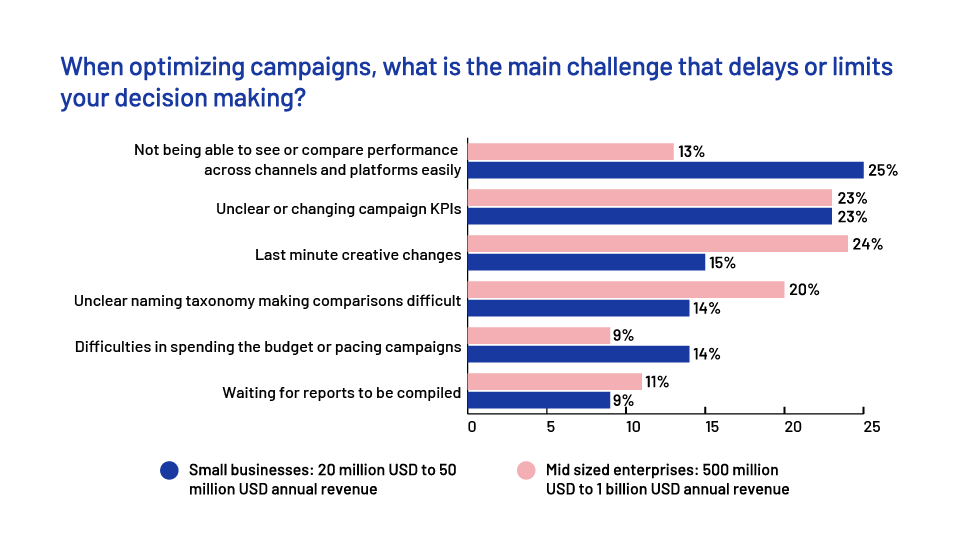
There are two sides to this coin. The first is that KPIs are always going to change, and that’s something marketing teams need to account for and adapt to. The past two years are a testament to the necessity for flexibility.
However, if the lack of clarity around KPIs comes from an internal problem, then this is something that needs to be addressed sooner than later. It may be that the C-suite doesn’t have a good enough understanding of the data to set clear KPIs — or it may be that the importance of clear KPIs in a data-driven strategy hasn’t been hammered home yet. Either way, a key responsibility for CMOs is to get these points across and draw clear and concise goals out of the company’s leadership team.
Out of the CMOs surveyed, 43% identified difficulty creating a data-driven culture as the biggest barrier to getting value from marketing data. The second biggest hindrance was not having the right tech to consistently deliver valuable insights from data (38%), followed by the challenge of having people with the right skillsets on the marketing team (19%).
Underneath the umbrella of culture, the biggest challenge is a lack of enthusiasm from leadership (17%). A data-driven culture needs to be driven from the top down to be truly effective, but it seems that CMOs at SMBs are having trouble getting the rest of the C-suite on side.
According to Jeff Coleman, Leader of Digital Marketing Science at Carter’s, marketers need to start by framing this in terms of business-critical questions. “Explain the problem, and how to solve the problem”, he says, “and then start to bring in how data is part of that solution.”
The second biggest culture challenge is cumbersome legacy workflows and the silos and bottlenecks that come with them (15%).
Legacy workflows are notoriously tricky to upturn, especially when they’ve forced members of your company, and even your team, into silos. It’s not always easy to take a step back and realize there’s an easier way. But we’re getting to the point where it’s harder to hold on to legacy workflows than it is to reinvent them. Investing in connecting up data across your team and your company isn’t the leap of faith it once was and the benefits are fast becoming too valuable for competitive organizations to ignore.
Smash those silos. If you have a marketing ops role, lean on them for an overview of your team and your company, and recommendations on how tech can democratize data and bridge certain gaps.
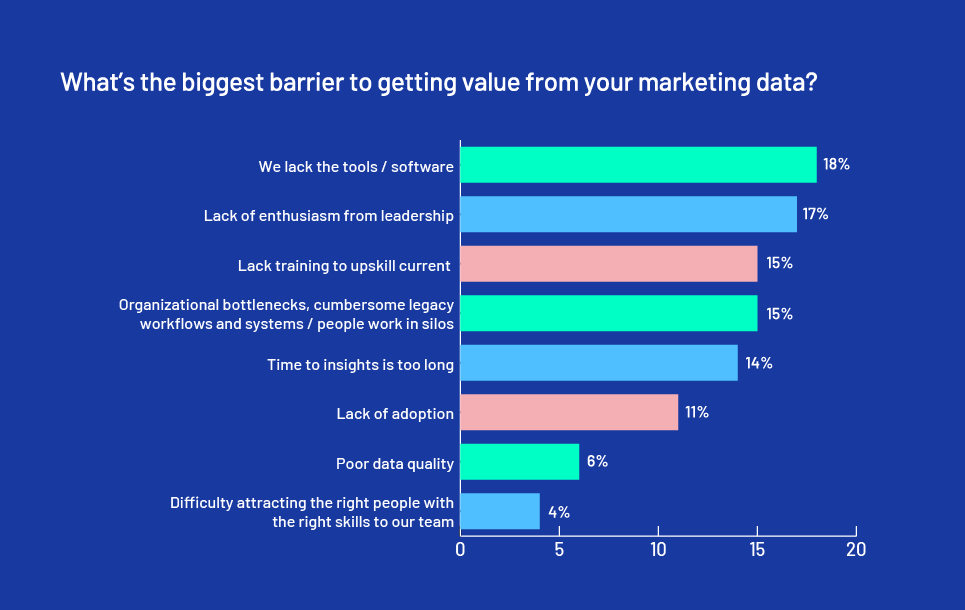
The biggest individual challenge to getting value from marketing data is a lack of data tools (18%). Without the right tools to take on the growing mountains of information coming from countless platforms, it’s easy to find yourself drowning in data. At the same time, 43% of CMOs surveyed say their team spends more time getting data in one place than they do actually using it to make decisions.
Aside from this kind of manual work being incredibly time-consuming, inefficient, and error-prone, CMOs at SMBs must carefully consider the environment they’re creating for their team. To get the most value out of your analysts, businesses should look at what data tools they can invest in to take mundane tasks off their plate.
“The ability to manage smart systems effectively is critical to producing the trustworthy, valuable insights they need to accurately measure ROI and make decisions; as is confidence in tools designed to make these tasks simpler and more streamlined, such as centralized data lakes, consolidated dashboards, and automated omnichannel reporting.”
- Harriet Durnford Smith, CMO, Adverity
There’s a skills gap at the moment. Marketing teams need data skills, but there’s a drought of fully trained marketing data professionals. 66% of CMOs surveyed say it’s harder to hire new employees with a data background than to upskill their current team. This might explain why only 4% see hiring as their main challenge to getting value from data: hiring fully data-fluent employees is too resource-intensive, so companies aren’t making this a focus.
What’s more, 36% have said that retention is becoming increasingly difficult, so even if you do find a fantastic data whizz, then there’s no guarantee that they’ll stick around — especially if amping up data maturity is an uphill battle because of the culture issues listed above.
In fact, this seems to be the reality for many respondents, as a further 49% of CMOs agreed that the amount of manual reporting required is putting people off wanting to work in their marketing team.
“Many organizations are employing data scientists and then filling up their time with mundane work like manually pulling together data from different sources. Not only does this undermine data quality, but it also means that analysts aren't able to use the advanced skills they were hired for.”
If you want data skills in your team, then you have to build an environment where they can survive, or risk falling victim to the great resignation. Telling a story with your data insights isn’t about cherry-picking results that back up your gut instinct. If you’re using your data well then it’s much harder to hide where your campaigns have fallen short — and marketers shouldn’t feel like they have to.
“You've got to create a safe culture where everyone is comfortable saying, ‘Yeah, it broke yesterday. And I was at the wheel when we drove the car into the wall,’”
Unless you have a big budget for hiring or a cutting-edge strategy to retain top-tier data talent, then hiring probably won't be the best way to go. But training current employees poses its own challenges. In fact, the fourth most pressing challenge is a lack of training to upskill employees (15%).
At the moment, there’s a gap between the data-savvy analysts (who have access to all the data tools) and the marketers (who have a much clearer picture of the marketing strategy). In fact, many marketers aren’t currently aware of the data tools their team has access to and the benefits they can bring. In order to reach a symbiosis between people and tech, analysts and marketers need to work together.
Google’s digital garage is only going to get you so far if you’re upskilling employees in silos. The key is to get analysts and marketing strategists on the same page. If their knowledge is sitting in two separate silos, then it is much less valuable. The most sophisticated marketing tech stack in the world is useless if its insights aren’t being translated into actions.
“Tech will inevitably become more marketer-friendly, and at the same time, marketers will become more data-savvy. First, we change the technology, then the technology changes us.”
When it comes to building a data-driven team, technology alone is not enough — it also requires having the right people with the right skills alongside an appropriate data-driven culture that allows them to flourish. CMOs and other senior leaders at SMBs are advised to invest in all three pillars when looking to improve the analytical maturity of their department.
As we’ve established, companies can’t have a truly data-driven strategy without the culture to support this. However, CMOs at SMBs will sometimes come up against resistance from members of the team who see their role as a purely creative one.
Many marketing teams haven’t yet reached this point where their data strategy is streamlined enough to take on the heavy lifting. Subsequently, CMOs are split on whether data helps or hinders creativity, with 42% saying data hinders creativity, and 41% saying it helps.
Addressing the gap between data and creativity can be a balancing act, but a good start for those who find data to be a hindrance is to focus on their tech strategy — CMOs at SMBs who say data greatly hinders creativity are twice as likely to struggle most with a lack of tools.
For those who find their creativity is greatly supported by data insights, their main issue is that they don’t have enough of them. They want more data insights, and they want them faster. This rings true with what our CMOs predict to be the key focus in the coming years. Being competitive isn’t about building a strategy around data anymore — it’s about building a strategy around insights.
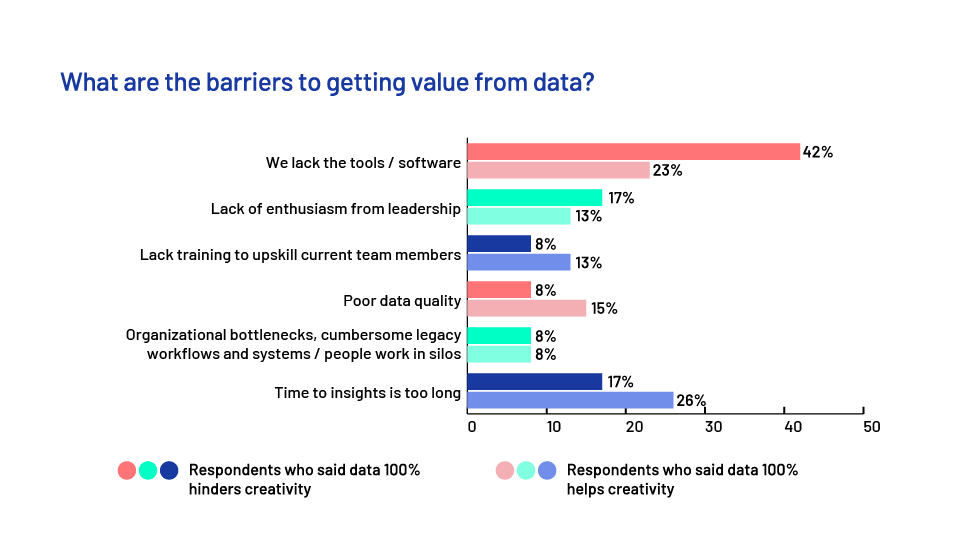
We often hear kickback from marketers who feel that putting data at the heart of a strategy sacrifices the creativity that drew them to the role in the first place, but the fact is that data and creativity don’t have to be at odds. In fact, data can support creativity in more ways than one.
The most obvious is by finding the right space that will give your team’s creatives better reach and more impact. No marketer wants to spend weeks on a campaign concept only to have it tank because it’s been published at the wrong time, or on the wrong channel.
Once you’ve streamlined the process for creating a clear view of marketing performance across all your channels, it’s much easier to spot channels that are performing well and give them a boost so that your ads have more impact. You’ll also be able to catch outliers like a sudden spike in CPC for certain adwords. This means you can reduce risk and avoid wasted ad spend by getting to these anomalies early on.
“Instead of looking at data as a time-consuming burden, agencies can instead explore how technology can take over much of the heavy-lifting, letting creatives get back to what they do best — being creative!” says Mitesh Lakhani, Director of Solutions Consulting at Adverity
The less obvious way that data draws creativity into the role is a bit more meta. Dany Eid, Head of North America at Adverity explains, “Creativity has evolved. While there may be less room for creativity within the marketing role in the traditional sense, data has opened up the door for marketers to find new and creative ways of using data to reach their audience.”
The amount and complexity of data that you can currently use to make marketing decisions is phenomenal. It goes beyond your typical marketing data like impressions, CTR, or sales figures — and I’m not just talking about cookies either. External data sources like footfall or weather data present a really interesting opportunity for marketing.
Wes Nichols, Partner at March Capital, recounts how he used data while working for a pharma company. “This company is a large producer of flu medicine and the CEO of that division every year was given a budget based on last year's flu season and sales,” he says, “But, last year's flu season is generally quite different than the next year's flu season. And so, every year they were either way over budgeted or way under-budgeted.”
However, once the company started building out a proper data set of what happened and what variables actually influenced the sale of this flu product, they started to create predictive levers.
“One thing that came out that was interesting was we saw public transportation numbers go down several days before the flu symptoms started to be googled,” says Wes, “And all of a sudden that gave a very interesting combination of tools that we could use to predictively prescribe marketing money based on starting to see dips in public transportation ridership.”
Commercial data analytics on this scale have existed for a while — mostly within the finance world. But now that they’re more accessible than ever before, it’s up to marketers to adapt that technology and start being creative with what data sets could hold huge amounts of value for them.
Respondents came from small and midsize businesses as defined by Gartner; small businesses are defined as organizations with an annual revenue of between 20 million and 50 million USD while mid-sized enterprises are defined as organizations with an annual revenue of between 50 million to 1 billion USD.
